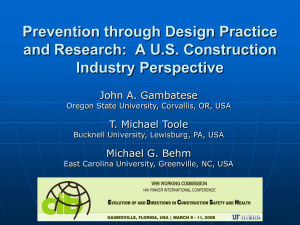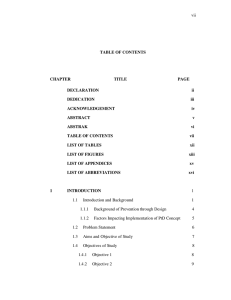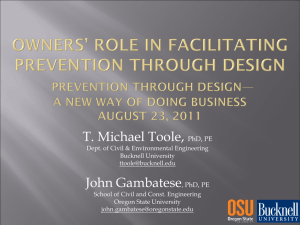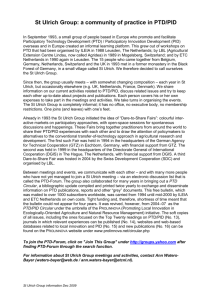Document 14593307
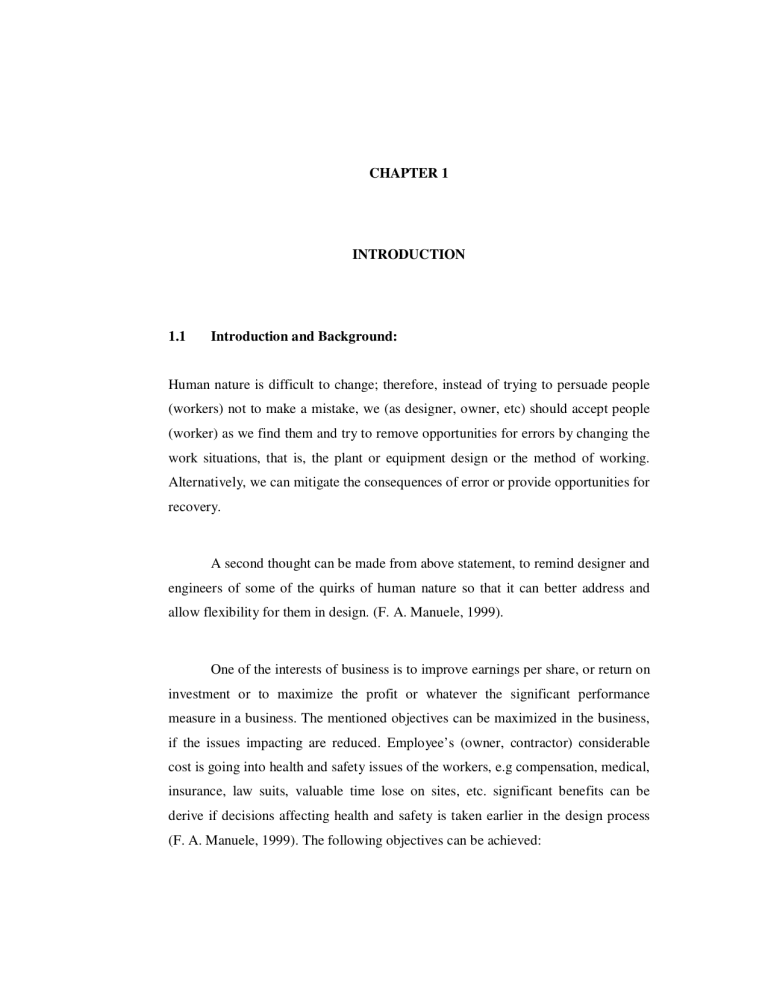
CHAPTER 1
INTRODUCTION
1.1
Introduction and Background:
Human nature is difficult to change; therefore, instead of trying to persuade people
(workers) not to make a mistake, we (as designer, owner, etc) should accept people
(worker) as we find them and try to remove opportunities for errors by changing the work situations, that is, the plant or equipment design or the method of working.
Alternatively, we can mitigate the consequences of error or provide opportunities for recovery.
A second thought can be made from above statement, to remind designer and engineers of some of the quirks of human nature so that it can better address and allow flexibility for them in design. (F. A. Manuele, 1999).
One of the interests of business is to improve earnings per share, or return on investment or to maximize the profit or whatever the significant performance measure in a business. The mentioned objectives can be maximized in the business, if the issues impacting are reduced. Employee’s (owner, contractor) considerable cost is going into health and safety issues of the workers, e.g compensation, medical, insurance, law suits, valuable time lose on sites, etc. significant benefits can be derive if decisions affecting health and safety is taken earlier in the design process
(F. A. Manuele, 1999). The following objectives can be achieved:
2
1.
2.
3.
4.
Significant reduction will be achieved in injuries, illness, damage to environment and their attendant costs.
Productivity will be improved
Reduction in operating cost
Time loses in design correction and queries can be reduced.
In this competitive construction environment, this is the right way for the owners to consider, rather than avoiding the safety. Studies have shown that every dollar spent on a good safety program can result in a four to eight dollar reduction in losses from accidents. Design stage is the time where safety precautions taken have the high impact on construction accidents (PMBOK 2000).
Higher fertility rates, billions of dollar cost in medical, law suits and in compensation, waste of time, reputation of firm, low morals of co-workers and various reasons put construction safety into core attention to many in the industry.
Prevention through Design and Safety through Design are the efforts taken to reduce the construction hazards during the design stage.
Studies have shown that the decision taken on design stage can cause a significant number of accidents and resulting injuries. The design impact on safety is evident, so the potential benefits of implementation of safety concept are significant
(Gambatese, 2005). And another research conducted in UK, found more than 42% of 224 fatality accident cases could be prevented by changes in the permanent design features (Gibb et al, 2004). It gives the opportunity to the designers to implement the PtD concept into design and save minor and major injuries
(Gambatese, 2005).
Another study shows that the conceptual phase and design development phase of the project have more ability in terms of cost and time to influence project safety (M. Behm, 2005).
3
High
Safety
Influence and Cost
Saving
Conceptual Design
Design Development
Procurement/Tender
Construction/Execution
Completion/
Handover
Low
Start
Project Life
Figure 1.1
: Time/Safety/cost Influence Curve (Source, Szymberski, 1997).
End
The above figure shows as the project progress over the time, the ability to influence safety of the project is decreasing, because the cost and time to address the safety is increases. And also the barriers to address safety of the project will increases. Wei Zhou (2012) said about this hypothetical time/safety influence curve by Szymberski (1997). It illustrates the idea that the ability to influence construction site safety is progressively lost as the project moves into the construction phase, with a significant opportunity in design. Furthermore, M. Weinstein’s (2005) finding shows that successful safety implementation can be enhanced through the consideration of design changes early in the project. This process should ideally start in the conceptual phase and continue through detailed design.
When we talk about safety in design, construction worker safety is not regarded as the design objectives or given the least priority (Gambatese, 2005).
During the design process safety is only considered for the end users (inhabitant, user of building). Safety of worker who involved during the construction and maintenance phase is largely neglected by the designers.
Due to the fact, the notion of Prevention through Design (PtD) has gained considerable importance among the government agencies and also in design community.
4
1.1.1
Background of Prevention through Design:
There is rich history in design to protect public and end user of buildings. All engineering disciplines have an inherent focus on safety of end user of the products.
A modern safety though design concept can be traced back in beginning in the
1800s, where efforts made into design for workers' safety. (Paul A. Schulte, 2008).
Prevention through Design (PtD) concept in engineering and design is not new. Chemical industry started implementing PtD concept into engineering and design, and can be said the pioneer of PtD application in engineering discipline. The principle of PtD concept has different names in different countries as ‘Safe Design’ in Australia, ‘Safety by Design’ or ‘Inherent or Intrinsic Safety’ in United Kingdom and ‘Safety though Design’, ‘Construction Hazard Prevention through Design
(CHPtD)’ and ‘Design for Construction Safety’ in United States (NZCIC, 2006).
In USA in early 1990s, a study undertook by Fred A. Manuele indicated that although there were implications of workplace and work method design inadequacies in over 35% of the investigational reports analyzed, the corrective actions proposed did not relate to design implications. (F.A. Manuele 2008).
Regulations in countries like UK, Australia and South Africa made to address PtD concept into design. Construction safety was considered the responsibility of constructor and client, and usually it was left upon the constructor of the project (OSHA). Since the introduction of Construction (Design and
Management) Regulation (CDM) in 1994 in UK, the culture of regarding the safety consideration into design is changing. The CDM Regulation states, “The designer of constructed facility should take into account foreseeable risks during the construction process”. It defines the designer’s duty in respect of reducing health and safety risks during construction to avoid hazards, combat risks and provide information. It makes designer responsible for the safety of the construction worker at the site. According to the CDM regulations in the UK, the best form of protection against a hazard is to eliminate the hazard at source. Where elimination or reduction of the impact of the hazard is not possible, the information about the hazard should
5 be provided so that it can be dealt with as safely as possible (Wright et al., 2003).
The CDM Regulation aims to bring a cultural change in construction industry, particularly in design community, by involving all those who are involved in the design and construction process to consider health and safety issues. CDM
Regulation 2007 also emphasis the appointment of CDM coordinator as early as possible to allow adequate time to address issues during the planning and design stage. (Wei Zhou, 2011).
1.1.2 Factors Impacting Implementation of PtD Concept:
There are many barriers faces by the designer which are hindrances in the implementation of PtD concept in order to design. Gambatese (2005) in his research conducted in USA, found out the following barriers in addressing the PtD into design: i.
OSHA’s placement of safety responsibility on employee (owner or contractor). ii.
Liability issues for designer iii.
Knowledge of designer about the concept. iv.
Acceptance of the PtD concept by the designer. v.
Designer’s education and training. vi.
Lack of design tools, guidelines, procedures. vii.
Designer’s limited role on the project team (traditional Design-Bid-
Build process). viii.
Absence of legislative mandate.
According to Gambatese (2005) Safety will not be considered in the design process if the designer is not aware of the concept or how to implement it, or does not accept it as part of design practice.
6
1.2
Problem Statement:
Not considering safety of construction and maintenance workers seems unethical and raises a host of ethical questions for designers.
Do not design professionals have the same duties for construction and maintenance workers as for the public? Are construction workers a less important group of people than the collective general public? Do not design professionals have ethical duties for reasonably minimizing all of the risks that they have control over, not just the risks that they are unlikely to be sued over? The safety of the public is given such a prominent position in the codes of ethics because it is recognized the public lacks the detailed technical knowledge of risks associated with structures that design professionals possess. Can design professionals state with certainty that construction workers possess the same set of technical knowledge and understanding of the risks associated with exposure to fall, physical forces, electricity and chemicals as do design professionals? These issues suggest that a designer who is not willing to consider design decisions that could reduce the inherent risks to construction workers to a reasonable level is not committed to maximizing the social equity of a project.
There is consensus among the all design and construction professionals that the design affects the cost, quality and duration of a construction project, so it makes some sense that the design can affects the inherent risk to the workers constructing the project.
The diffusion of PtD has been hampered by several practical factors.
Research shows that designers (those who are aware of the PtD concept) want to implement into design. But due to lack of guidelines, safety tools, process and procedures barriers (i.e., lack of a standardized approach, and undefined structures for tasks and hazards), difficulty in determining the stage of design review, check lists, best practice, identifying the responsible person to address, how to identify the construction hazards, knowledge and information barriers, etc, are the main hurdles faced by the designers. (Gambatese; 2005, M. Behm; 2008, M. Gangolells, 2010).
7
This is because designers don’t have the formal training of safety and lack of construction experience (Gambatese, 2005). And also addressing the safety of construction workers into design is not inherent objective of a design process.
It shows that designers are seriously lacking in safety design tools and safety design process, which can be customized by type of firm, by the firm size and also should consider the procurement method adopted for the project. PtD concept cannot be implemented until: i.
ii.
It not seen as a core objective of design process articulated by the design process head.
Designers are trained on fundamentals of construction safety and on applying PtD within the design. iii.
Safety tools, design checklists and other process and procedures are developed to identify PtD opportunities in the design. iv.
Processes also required to ensure design managers to monitor the effectiveness of the PtD efforts and documentation of identified construction hazards for further use in project execution.
1.3
Aims and Objective of Study
The idea came into mind why designers don’t have any framework for addressing safety of construction workers into design. The example of implementation of sustainability concept can be taken, designers have the framework for sustainability (G. Bill, 2011), why designer don’t have any framework for the safety concept. The question here is, do we need such a framework? Yes, we need it for several reasons.
Fortunately the barriers impacting the PtD concept implementation into design can be addressed by a framework of PtD concept implementation into design process and making it an integral part of design objectives like other design
8 objectives of project (i.e cost, time, quality, aesthetics, sustainability, etc). The goals of applying prevention through design principles into design process are to: i.
Achieve safety, defined as that state for which the risks are at an acceptable level, and ii.
Minimize the occurrence of occupational injuries, illnesses and fatalities.
The aim of this study is to propose a conceptual framework for designer for the implementation of PtD concept into design process. This will help designers to address construction worker’s safety into design process and will enhance the integration of different design professionals. This integration of various design professionals will also enhance the decision making at the early stages of project to select the effective design within the cost, time and quality parameters of project and reducing the construction hazards into an acceptable level.
1.4
Objectives of Study
The objectives of this study are follows: ii.
iii.
i.
To study the building design process.
To study the factors affecting the design process.
To develop a conceptual framework for the implementation of PtD.
1.4.1
Objective 1
Design development models will be reviewed for better understanding of design process. It is also important to study the design process models to know
9 which models are being used and widely accepted by the designers and why designer adopted it.
This study will help to identify the strong and weak points of design process models. Strong points will be incorporated into proposed conceptual framework and weak area will be improved.
By critically analyzing widely used design process models, one best design model will be selected for proposed conceptual framework. Here intention is not to develop any new design process model but selecting a best design process model and modifying into PtD implementation model. Few additions will be done in the existing model for PtD conceptual model.
1.4.2
Objective 2
This objective will be carried out by studying the factors affecting the design process. It is important to identify the critical and other important success factors behind the success and widely acceptance of the design process model. If the success factors ingredients are known and are well implemented, then the widely acceptance of a new conceptual framework is inevitable.
1.4.3
Objective 3
A conceptual framework will be developed keeping in mind the previous identified design model in objective one and the factors affecting the design process in objective two.
10
1.5
Research Scope and Limitations:
As mentioned earlier designers are lacking in knowledge, construction experience and process and procedure to adopt PtD concept into design. If these all hindrances are removed, a considerable amount of injuries and fatalities can be avoided, and safe working environment can be provided to workers in all phases of building life cycle.
This study will only focus the safety precautions in the design stage by identifying, eliminating, substituting and reducing construction hazards up to acceptable level. The safety procedures taken during the construction stage is not scope of this study. Where ever the term construction workers are mentioned, it means the workers involved during the project execution and workers involved during the maintenance of the building.
The area chosen for this study is Pakistan. As a developing country, the share of construction activities in GDP of Pakistan is higher. The fatalities rate is also very high (most of the accidents are not documented and also don’t have any central agency to collect data across the country). The design process studied for this study is limited to the current practice of Architectural Design in Pakistan only.
This study will propose the conceptual framework for the implementation of
PtD into Design Process, here the testing and implementation of the model in the industry is not included.
Validity and acceptance level of the conceptual framework is not included in the study for the shortage of time. Conceptual framework model can be applied to any country, but it is developed keeping in mind the architectural practices in
Pakistan.
11
1.6 Significant of Study:
There is a good example of sustainability, how it is now the integral part of building design, no design is considered complete unless a careful sustainable measure has been taken. Behm (2008) said that we can apply sustainability concept also for the PtD implementation.
Sustainability is now considered a key responsibility of designer. This all happens by developing the design process and procedures to address sustainability and removing the barriers faced by the designers.
This study will discuss how PtD concept can be applied into design process and propose a conceptual framework for implantation of PtD into design process.
The framework will help designers to identify the roles and responsibilities, hazard identification process, information sharing, output of each design activity and also help in monitoring and controlling the safety design process.
Gambatese (2005) listed some of the outcome of the successful implementation of PtD concept in design: i.
ii.
iii.
Construction worker safety.
Project cost, quality, constructability, schedule, etc
Completed facility characteristics: design features, operability, operator safety, maintainability, etc iv.
v.
vi.
Design firm liability, productivity, profitability, etc and
High worker’s moral (accidents and injuries decrease the moral)
Reduction in compassion cost.



